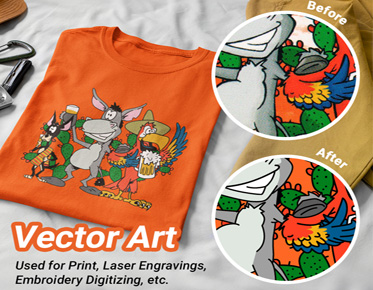Vietnamese Digitized Embroidery: Old School Meets New Tools
Vietnamese embroidery is a timeless craft that beautifully intertwines tradition with artistry. This ancient art form, known for its intricate designs and vibrant colors, has captivated the hearts of many for generations. As technology advances, the fusion of traditional embroidery with modern digitization opens up a new chapter in preserving and enhancing this cultural treasure.
The Art of Vietnamese Embroidery: A Quick Overview
A Rich Cultural Heritage: The Origins of Vietnamese Embroidery
Vietnamese embroidery traces its roots back centuries, flourishing under the Nguyen Dynasty. Embroidery, or "thêu," became a symbol of wealth and status, with elaborate patterns adorning royal garments and household items. Each stitch tells a story, reflecting the country's rich history and cultural diversity.
Traditional vs. Modern Techniques: An Evolution
While traditional Vietnamese embroidery relies on meticulous hand-stitching, modern techniques have introduced innovative tools and methods. Hand-stitched pieces, revered for their uniqueness and personal touch, now coexist with machine-assisted creations. This evolution has made embroidery more accessible and varied, appealing to a broader audience.
What is Digitized Embroidery?
Defining Digitized Embroidery
Digitized embroidery involves converting traditional embroidery designs into digital formats that can be executed by computerized embroidery machines. This process allows for precise and consistent reproduction of intricate patterns, blending craftsmanship with technology.
How Digitized Embroidery Works: The Basics
The digitization process begins with creating or scanning a design, which is then converted into a digital file using specialized software. This file guides the embroidery machine, detailing each stitch's placement, color, and type. The result is a flawless replication of the original design, executed with speed and precision.
The Rise of Digital Techniques in Vietnamese Craftsmanship
Digital techniques have revolutionized Vietnamese embroidery, enabling artisans to preserve traditional patterns while experimenting with new designs. This technological advancement ensures that the art form remains relevant and sustainable in a rapidly changing world.
The Intersection of Tradition and Technology
Bridging the Gap: From Hand-Stitched to Digitally Designed
Digitized embroidery bridges the gap between hand-stitched masterpieces and modern efficiency. While the human touch imparts soul to each piece, digital methods offer uniformity and scalability, allowing for large-scale production without compromising quality.
Preserving Heritage Through Modern Means
Digital technology plays a crucial role in preserving Vietnamese embroidery's rich heritage. By digitizing traditional patterns, artisans can safeguard these cultural symbols for future generations, ensuring they are not lost to time.
Benefits of Digitizing Traditional Designs
Digitizing traditional designs offers numerous benefits, including enhanced precision, reduced labor time, and the ability to experiment with variations without starting from scratch. This blend of tradition and technology fosters creativity while honoring the past.
Tools and Software for Digitized Embroidery
Must-Have Software for Embroidery Design
Essential software for digitized embroidery includes programs like Adobe Illustrator for vector design, Wilcom for intricate pattern creation, and Hatch Embroidery for user-friendly editing. These tools include an extensive amount of functionality for bringing your concepts to life.
Hardware Essentials: Machines and Gadgets
High-quality embroidery machines, such as those by Brother, Janome, and Bernina, are vital for digitized embroidery. These machines, equipped with advanced features, ensure precision and consistency. Additionally, gadgets like digitizing tablets can streamline the design process.
User-Friendly Tools for Beginners
For beginners, user-friendly tools like Embrilliance and PE-Design Lite offer intuitive interfaces and simplified workflows, making it easier to dive into the world of digitized embroidery.
Creating Digitized Embroidery Designs
Inspiration from Traditional Patterns
Drawing inspiration from traditional Vietnamese patterns can imbue your designs with cultural depth. Elements like the lotus flower, dragon, and phoenix hold significant meanings and add a touch of authenticity.
Step-by-Step Guide: From Concept to Digital Design
1. Conceptualization: Begin with a rough sketch of your design.
2. Digitization: Scan the sketch and use software to convert it into a digital format.
3. Refinement: Adjust details, colors, and stitch types in the software.
4. Testing: Run a test on your embroidery machine to ensure accuracy.
5. Finalization: Make any necessary adjustments and finalize your design.
Tips for Creating Detailed and Accurate Designs
Pay attention to stitch density and thread tension to maintain detail and accuracy. Experiment with different stitch types to add texture and dimension. Regularly preview your design in the software to catch any issues early.
Challenges in Digitizing Vietnamese Embroidery
Maintaining Authenticity in Digital Formats
One challenge is maintaining the authenticity and soul of traditional designs in digital formats. To overcome this, ensure that digital reproductions respect the original patterns' intricacies and cultural significance.
Technical Hurdles and How to Overcome Them
Technical challenges, such as software learning curves and machine maintenance, can be daunting. Invest time in learning and practicing with your tools, and don’t hesitate to seek help from online communities and tutorials.
Ensuring Quality and Precision
Achieving high quality and precision requires a combination of skill and the right tools. Regularly calibrate your machine, use high-quality threads, and meticulously check your designs for errors before production.
Applications of Digitized Embroidery
Fashion: Bringing Vietnamese Embroidery to Modern Clothing
Digitized embroidery breathes new life into fashion, allowing designers to incorporate traditional Vietnamese patterns into contemporary clothing. This fusion of old and new creates unique, culturally rich fashion statements.
Home Décor: Adding a Touch of Tradition to Everyday Items
From decorative pillows to wall hangings, digitized embroidery can transform ordinary home décor items into extraordinary pieces that celebrate Vietnamese heritage.
Art Installations and Cultural Displays
Artists and curators are increasingly using digitized embroidery in installations and cultural exhibits. These projects highlight the craftsmanship and historical significance of Vietnamese embroidery, making it accessible to a global audience.
Popular Vietnamese Embroidery Motifs
Symbolic Patterns and Their Meanings
Vietnamese embroidery is rich with symbolic patterns, such as the dragon (power and prosperity), the phoenix (rebirth and immortality), and the lotus (purity and enlightenment). Each motif carries deep cultural significance, adding layers of meaning to the designs.
Regional Variations in Design
Different regions in Vietnam have distinct embroidery styles. Northern Vietnam is known for its meticulous and detailed work, while the southern regions often feature more vibrant and bold patterns. These regional variations contribute to the rich tapestry of Vietnamese embroidery.
Modern Interpretations of Classic Motifs
Modern interpretations of classic motifs blend traditional symbolism with contemporary aesthetics. Designers are reimagining these patterns in new contexts, keeping the art form dynamic and relevant.
Successful Digitized Embroidery Projects
Innovative Fashion Designers Using Digitized Embroidery
Designers like Thuy Nguyen have successfully integrated digitized Vietnamese embroidery into their collections, creating pieces that resonate globally while honoring traditional craftsmanship.
Cultural Projects Preserving Heritage Through Technology
Projects like the "Vietnam Heritage Embroidery Initiative" utilize digitization to preserve and promote traditional patterns, ensuring they remain a vibrant part of cultural heritage.
Small Businesses and Artisan Success Stories
Many small businesses and artisans have embraced digitized embroidery, creating bespoke products that appeal to modern consumers while supporting traditional crafts.
Customization and Personalization
Custom Orders: Meeting Unique Client Needs
Digitized embroidery allows for a high degree of customization, enabling artisans to meet unique client needs with precision. From personalized gifts to bespoke fashion pieces, the possibilities are endless.
Personal Projects: Making Your Digitized Embroidery
Digitized embroidery isn't just for professionals. Hobbyists can use this technology to create personalized projects, from monogrammed towels to custom artwork.
The Growing Trend of Personalized Embroidery
Personalized embroidery is a growing trend, driven by consumers' desire for unique and meaningful items. Digitized techniques make it easier than ever to create one-of-a-kind pieces.
The Future of Vietnamese Digitized Embroidery
Emerging Trends in Digital Embroidery
Trends such as 3D embroidery, augmented reality integration, and interactive textiles are pushing the boundaries of what digitized embroidery can achieve.
The Role of AI and Machine Learning
AI and machine learning are revolutionizing digitized embroidery by automating complex tasks, predicting design outcomes, and enhancing precision.
Predictions for the Future of Traditional Crafts in a Digital World
The future of traditional crafts like Vietnamese embroidery lies in their ability to adapt and evolve with technology. Digitization ensures these crafts remain relevant and appreciated in a modern context.
Commercializing Your Digitized Embroidery Skills
Setting Up Your Own Business
Starting a business in digitized embroidery involves creating a portfolio, investing in quality equipment, and developing a marketing strategy to reach your target audience.
Marketing Your Designs
Effective marketing includes leveraging social media, creating an online store, and participating in craft fairs to showcase your designs.
Selling on Online Platforms
Platforms like Etsy and Amazon Handmade provide excellent opportunities to sell digitized embroidery products to a global market.
Sustainability in Digitized Embroidery
Eco-Friendly Practices and Materials
Adopting eco-friendly practices, such as using organic threads and sustainable fabrics, can reduce the environmental impact of digitized embroidery.
The Impact of Digital Methods on Sustainability
Digital methods can enhance sustainability by minimizing waste, optimizing resource use, and reducing the carbon footprint associated with traditional embroidery.
Supporting Ethical Craftsmanship
Supporting ethical craftsmanship involves ensuring fair wages and working conditions for artisans and promoting practices that respect cultural heritage.
Tips and Tricks for Perfect Digitized Embroidery
Troubleshooting Common Issues
Common issues like thread breakage, design misalignment, and software glitches can be mitigated by regular maintenance and careful planning.
Enhancing Your Designs with Advanced Techniques
Advanced techniques such as layering, gradient fills, and 3D effects can add depth and dimension to your digitized embroidery designs.
Keeping Up with Industry Trends
Staying updated with industry trends through blogs, webinars, and industry publications can keep your skills sharp and your designs fresh.
The fusion of traditional Vietnamese embroidery with modern digitization techniques offers a unique opportunity to preserve and innovate this cherished art form. By embracing both heritage and technology, we can keep this cultural treasure alive for future generations.
Whether you're a seasoned artisan or a curious beginner, exploring digitized embroidery opens up a world of creative possibilities. Dive in and discover the joy of combining tradition with innovation.



